跨文化交际1
跨文化交际1

1.跨文化交际引起重视的原因 1.跨文化交际引起重视的原因 交通工具的进步与通讯手段的发展使得不同国家、 不同种族、不同民族的人能够频繁地接触和交往 L.S Harms:语言的产生;文字的使用;印刷技 Harms: 术的发明;近百年交通工具的进步和通讯手段的 迅速发展;跨文化交际 2.对跨文化交际的不同理解及原因 2.对跨文化交际的不同理解及原因 一种看法是任何两个人之间的交际都是跨文化交 际 Australian and American Interractions American Interactions with Israelis 在作文化比较时似乎可以大到东西方对比,小到 两个人之间的对比。中间还有种族、民族、国家、 地区、阶级、阶层、职业、性别、年龄等等层次 主流文化-亚文化-地区文化主流文化-亚文化-地区文化-小群体文化(不同年 龄、职业、性别群体的文化)
跨文化交际
Introduction
一、跨文化交际是指来自不同文化 一、跨文化交际是指来自不同文化 背景的个体、群体或组织之间进行 背景的个体、群体或组织之间进行 的交流活动。
以下哪些是跨文化交际 A外交部长与他国人员谈判 B公司工作人员与外国人谈生意 C我们与泰国学生老师交往 D阅读外国小说 E观看外国电影、电视节目
R.T Oliver Culture and Communication A. Smith Communication and Culture I. Parry The Psychology of Human Communication 2.在传播学(Communication)理论基 2.在传播学(Communication)理论基 础上, 础上,与人类学、心理学、语言学、 文化学以及社会学等相互交叉而发 展起来的学科。
跨文化交际1(陆琳)
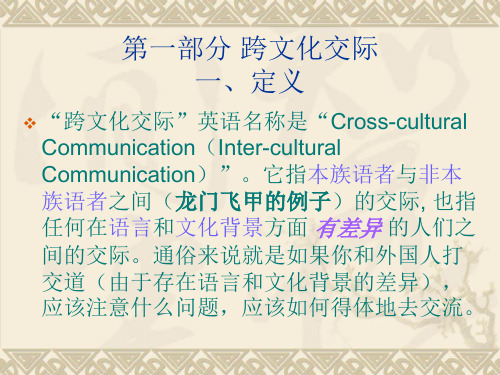
3、文化背景对语言的影响
好,我们前面说了语言是文化的一部分,反过来说,文化也会 深刻地影响语言。就拿我们刚才所说的朝鲜与韩国之间的交际 来举例,虽然他们所说的都是韩语(或者叫朝鲜语)但是在某 些事物的名称上会有不同。比如说,韩国是一个受美国文化影 响非常深刻的国家,美国的各种事物源源不断地涌入韩国社会, 成为了韩国人生活中的一部分。由此,出现了很多将英文名称 直接翻成韩语从而替代了韩语中原本用来指代某个事物的词汇。 比如说,正宗的韩语说用______来指电脑,而现在的韩国社会, 大家普遍以computer()来指电脑。原来的指电脑的这个词已 经逐渐被韩国人所遗忘,特别是年轻一代,甚至连__是什么意 思都不知道。而这个词,在朝鲜却依然被人们广泛的使用者。 那么请在座的老师们设想一下,一个韩国人在与自己的朝鲜同 胞交际的过程中,朝鲜人说___这个单词,对于已经习惯于用英 语的发音来指computer的韩国人,他是否能明白同胞的意思呢? 这样一来,双方的交际就出现了问题。诸如computer这样的词 汇,在韩国还有很多,比如ice-cream,chocolate。。。。
1.交际双方必须来自不同的文化背景
文化背景的差异是一个宽泛的概念,既是指不同文化圈之间 的差异,也是指同一文化圈内部亚文化之间的差异。不过立 足对外汉语专业,文化差异主要指不同文化圈之间的差异, 尤其是中国和欧美国家的文化差异。
因为从跨文化交际的实际情形来看,由于文化背景的差异导 致交际失误,容易引起冲突的主要是中国和欧美国家的人际 交往。(电影刮痧的例子)中国同亚洲地区国家,如日本、 韩国以及东南亚一些 国家的人际交往,虽然也有文化差异的 一面,但要顺利的多,这是因为这些国家与中国同属东方文 化圈,彼此在文化取向和交际规范方面有很多相通的地方。
跨文化交际 unit 1Communication1

关于用语
关于标点
关于空间
关于标题
独立知识点与概念 主题鲜明 标题字数 尽量人性化 分级标题的之间的逻辑性
关于空间
先见文,后见图、表 行长一般以 80-100mm 为适 最有价值信息放在最前面 页面力求丰满
关于文字
增进文字易读性
能见度(visibility) 能辨度(legibility) 能解度(readability)
同类演讲次数
根源(1)观众的数量规模
根源(2)内容的熟悉程度
关于成功者
做别人不敢做的事 做别人不愿做的事 做别人做不了的事
成功其实开始于下定决心
并全力以赴
演讲成功四要素
明确目标 以终为始 知彼知已 组织内容 主题大纲 加味添料 注重细节 呈现形式 用图表说话 PPT制作常识 预演彩排 开场白与结束 避免事项
倾听技巧
• 适当的作笔记; • 关注对方的肢体语言
– – – – 面部表情 姿势 个人空间 语音语调
What is culture?
• The term “culture” was first used in this way by the pioneer English Anthropologist Edward B. Tylor (1832-1917)in his book, Primitive Culture, published in 1871.
加味添料
多媒体 实验
适当的幽默
案例 游戏 实践演练
人性故事
针对性的问题
比喻/证据/示范
加味添料掌握技巧
问一个煽动性问题 引用名人精句 让数字说话 讲述主题相关的亲身经历 摘述最近新闻焦点
备课教案第一章跨文化交际

备课教案第一章跨文化交际一、引言跨文化交际是指不同文化下的个体之间进行沟通和交流的过程。
在全球化的下,跨文化交际的重要性越来越被人们所重视。
在教育领域,培养学生的跨文化交际能力已成为一项重要任务。
本教案的第一章将介绍跨文化交际的概念、原则和意义,并提供一些教学方法和策略。
二、跨文化交际的概念跨文化交际是指在不同文化下,个体之间进行交流和互动的过程。
跨文化交际涉及到语言、文化、社会习俗和价值观等方面的差异。
在跨文化交际中,个体需要理解和尊重对方的文化差异,同时要注意自己在交际中所表现出来的行为和态度。
三、跨文化交际的原则1.尊重差异:在跨文化交际中,应该尊重对方的文化差异,包括语言、礼仪、思维方式等方面的差异。
不应该对对方的文化进行歧视或偏见。
2.适应变化:在跨文化交际中,个体需要适应不同的文化环境和情境。
需要灵活地调整自己的行为和态度,以便更好地与对方进行交流。
3.建立共同语言:虽然语言可能是跨文化交际中的一个障碍,但个体可以通过学习对方的语言,或者使用一种中性的语言来建立共同的语言,从而更好地进行交流。
4.接纳多样性:在跨文化交际中,个体需要接纳不同的文化观念和价值观。
要意识到每个文化都有其独特的优点和特点,不应该将自己的文化观念强加于他人。
四、跨文化交际的意义跨文化交际具有重要的意义,它可以促进不同文化之间的交流和理解,有助于消除文化冲突和误解。
在教育领域,培养学生的跨文化交际能力可以帮助他们更好地适应多元文化的社会,并且能够为未来的国际交流和合作提供基础。
五、跨文化交际的教学方法和策略1.多元文化教育:在教学中注重引入多元文化的内容和案例,让学生了解不同文化的差异和特点。
2.语言对比学习:通过对比不同文化下的语言差异,帮助学生理解文化之间的差异,从而更好地进行跨文化交际。
3.资源共享:鼓励学生分享自己的文化和经验,这样可以促进学生之间的互相了解和交流。
4.情景模拟:通过模拟真实的跨文化交际情景,让学生在实践中学习如何应对文化差异和问题。
跨文化交际实用教程unit1重点词汇及问题
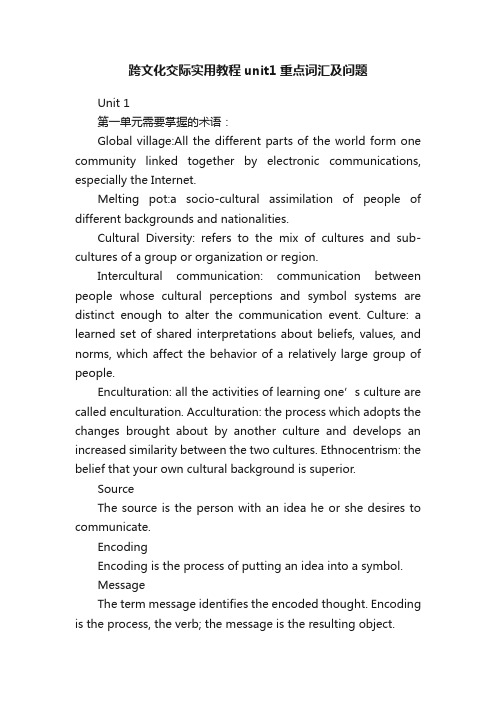
跨文化交际实用教程unit1重点词汇及问题Unit 1第一单元需要掌握的术语:Global village:All the different parts of the world form one community linked together by electronic communications, especially the Internet.Melting pot:a socio-cultural assimilation of people of different backgrounds and nationalities.Cultural Diversity: refers to the mix of cultures and sub-cultures of a group or organization or region.Intercultural communication: communication between people whose cultural perceptions and symbol systems are distinct enough to alter the communication event. Culture: a learned set of shared interpretations about beliefs, values, and norms, which affect the behavior of a relatively large group of people.Encul turation: all the activities of learning one’s culture are called enculturation. Acculturation: the process which adopts the changes brought about by another culture and develops an increased similarity between the two cultures. Ethnocentrism: the belief that your own cultural background is superior.SourceThe source is the person with an idea he or she desires to communicate.EncodingEncoding is the process of putting an idea into a symbol.MessageThe term message identifies the encoded thought. Encoding is the process, the verb; the message is the resulting object.ChannelThe term channel is used technically to refer to the means by which the encoded message is transmitted. The channel or medium, then, may be print, electronic, or the light and sound waves of the face-to-face communication.NoiseThe term noise technically refers to anything that distorts the message the source encodes.ReceiverThe receiver is the person who attends to the message.DecodingDecoding is the opposite process of encoding and just as much an active process. The receiver is actively involved in the communication process by assigning meaning to the symbols received.Receiver responseReceiver response refers to anything the receiver does after having attended to and decoded the message.(信息接受者在收到并解码/理解信息之后所作出的反应)FeedbackFeedback refers to that portion of the receiver response of which the source has knowledge and to which the source attends and assigns meaning.(信息接受者所作出的反应中能让信息发送者收到并理解的那一部分)ContextGenerally, context can be defined as the environment in which the communication takes place and which helps define the communication.五、简答和案例分析1. What are the four trends that lead to the development of the global village?The four trends that lead to the development of global village are:1) Convenient transportation systems;2) Innovative communication systems;3) Economic globalization;4) Widespread migration(p.8-9)2. What are the three aspects where the cultural differences exist?The three aspects where the cultural differences exist are:1) the material and spiritual products people produce2) what they do 3) what they think3. What are the three ingredients of culture?The three ingredients of culture are:1) artifacts 2) behavior3) concepts (beliefs, values, world views…)4. How to understand cultural iceberg?Just as an iceberg which has a visible section above the waterline and a larger invisible section below the waterline, culture has some aspects that are observable and others that can only be suspected and imagined. Also like an iceberg, the part of culture that is visible is only a small part of a much bigger whole. It is said nine-tenth of culture is below the surface. (pg. 7)5. What are the characteristic of culture?1) Culture is shared,2) Culture is learned,3) Culture is dynamic,4) Culture is ethnocentric.6. What are the characteristic of communication?1) Communication is dynamic2) Communication is irreversible3) Communication is symbolic4) Communication is systematic5) Communication is transactional. (pg. 8)6) Communication is contextual. (pg. 8)7. How is Chinese addressing different from American addressing?1) In China, the use of given names is limited to husband and wife, very close friends, juniors by elders or superiors, while more English-speaking people address others by using the first name, even when people meet for the first time.2) Chinese often extend kinship terms to people not related by blood or marriage. These terms are used after the surname to show politeness and respect. (pg. 23), but The English equivalents of the above kinship terms are not so used.3) In Chinese, people use a person’s title, office, or profession in addressing people. In English, only a few occupations or titles are used .8. How is the Chinese writing style different from the American style?1) Some oriental writing…is marked by what may be called an approach by indirection. In this kind of writing, the development of the paragraph may be said to be ‘turning and turning in a widening gyre.’The circles or gyres turn around the subject and show it from a variety of tangential views, but the subject is never looked at directly. Things are developed in terms of what they are not, rather than in terms of what they are.”2) An English paragraph usually begins with a topic statement, and then, by a series of subdivisions of that topic statement, each supported by example and illustrations,proceeds, to develop that central idea and relate that idea to all other ideas in the whole essay, and to employ that idea in it proper relationship with the other ideas, to prove something, or perhaps to argue something.”9. What are the different features of M-time and P-time?回答时注意:Monochronic 和Polychronic 两项都要列举几条,八条不用都回答上,但是第一条一定要回答上。
跨文化交际答案
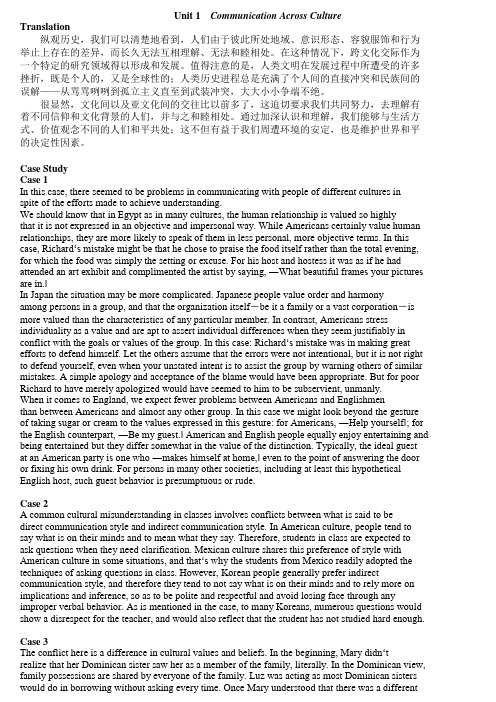
Unit 1 Communication Across CultureTranslation纵观历史,我们可以清楚地看到,人们由于彼此所处地域、意识形态、容貌服饰和行为举止上存在的差异,而长久无法互相理解、无法和睦相处。
在这种情况下,跨文化交际作为一个特定的研究领域得以形成和发展。
值得注意的是,人类文明在发展过程中所遭受的许多挫折,既是个人的,又是全球性的;人类历史进程总是充满了个人间的直接冲突和民族间的误解——从骂骂咧咧到孤立主义直至到武装冲突,大大小小争端不绝。
很显然,文化间以及亚文化间的交往比以前多了,这迫切要求我们共同努力,去理解有着不同信仰和文化背景的人们,并与之和睦相处。
通过加深认识和理解,我们能够与生活方式、价值观念不同的人们和平共处;这不但有益于我们周遭环境的安定,也是维护世界和平的决定性因素。
Case StudyCase 1In this case, there seemed to be problems in communicating with people of different cultures in spite of the efforts made to achieve understanding.We should know that in Egypt as in many cultures, the human relationship is valued so highlythat it is not expressed in an objective and impersonal way. While Americans certainly value human relationships, they are more likely to speak of them in less personal, more objective terms. In this case, Richard…s mistake might be that he chose to praise the food itself rather than the total evening, for which the food was simply the setting or excuse. For his host and hostess it was as if he had attended an art exhibit and complimented the artist by saying, ―What beautiful frames your pictures are in.‖In Japan the situation may be more complicated. Japanese people value order and harmonyamong persons in a group, and that the organization itself-be it a family or a vast corporation-is more valued than the characteristics of any particular member. In contrast, Americans stress individuality as a value and are apt to assert individual differences when they seem justifiably in conflict with the goals or values of the group. In this case: Richard…s mistake was in making great efforts to defend himself. Let the others assume that the errors were not intentional, but it is not right to defend yourself, even when your unstated intent is to assist the group by warning others of similar mistakes. A simple apology and acceptance of the blame would have been appropriate. But for poor Richard to have merely apologized would have seemed to him to be subservient, unmanly.When it comes to England, we expect fewer problems between Americans and Englishmenthan between Americans and almost any other group. In this case we might look beyond the gesture of taking sugar or cream to the values expressed in this gesture: for Americans, ―Help yourself‖; for the English counterpart, ―Be my guest.‖ American and English people equally enjoy entertaining and being entertained but they differ somewhat in the value of the distinction. Typically, the ideal guest at an American party is one who ―makes himself at home,‖ even to the point of answering the door or fixing his own drink. For persons in many other societies, including at least this hypothetical English host, such guest behavior is presumptuous or rude.Case 2A common cultural misunderstanding in classes involves conflicts between what is said to bedirect communication style and indirect communication style. In American culture, people tend to say what is on their minds and to mean what they say. Therefore, students in class are expected to ask questions when they need clarification. Mexican culture shares this preference of style with American culture in some situations, and that…s why the students from Mexico readily adopted the techniques of asking questions in class. However, Korean people generally prefer indirect communication style, and therefore they tend to not say what is on their minds and to rely more on implications and inference, so as to be polite and respectful and avoid losing face through any improper verbal behavior. As is mentioned in the case, to many Koreans, numerous questions would show a disrespect for the teacher, and would also reflect that the student has not studied hard enough. Case 3The conflict here is a difference in cultural values and beliefs. In the beginn ing, Mary didn…trealize that her Dominican sister saw her as a member of the family, literally. In the Dominican view, family possessions are shared by everyone of the family. Luz was acting as most Dominican sisters would do in borrowing without asking every time. Once Mary understood that there was a differentway of looking at this, she would become more accepting. However, she might still experience the same frustration when this happened again. She had to find ways to cope with her own emotional cultural reaction as well as her practical problem (the batteries running out).Case 4It might be simply a question of different rhythms. Americans have one rhythm in their personaland family relations, in their friendliness and their charities. People from other cultures have different rhythms. The American rhythm is fast. It is characterized by a rapid acceptance of others. However, it is seldom that Americans engage themselves entirely in a friendship. Their friendships are warm, but casual, and specialized. For example, you have a neighbor who drops by in the morning for coffee. You see her frequently, but you never invite her for dinner --- not because you don…t think she could handle a fork and a knife, but because you have seen her that morning. Therefore, you reserve your more formal invitation to dinner for someone who lives in a more distant part of the city and whom you would not see unless you extended an invitation for a special occasion. Now, if the first friend moves away and the second one moves nearby, you are likely to reverse this --- see the second friend in the mornings for informal coffee meetings, and the first one you will invite more formally to dinner.Americans are, in other words, guided very often by their own convenience. They tend to make friends easily, and they don…t feel it necessary to go to a great amount of trouble to see friends often when it becomes inconvenient to do so, and usually no one is hurt. But in similar circumstances people from many other cultures would be hurt very deeply.Unit 2 Culture and CommunicationTranslation文化有时候被称为我们的心智程序,我们“头脑的软件”。
【精选】跨文化交际word版(1)

Unit 1 introduction一.文化文化是冻结了的人际交流,而交流是流动着的文化----W.B. Pearce, 1994.背景:长期以来,文化被认为是无处不在,无所不包的人类知识和行为的总体。
被笼统地当作“生活方式”,社会生活的一切方面,积淀物,价值观念体系,众多规范,乃至艺术,政治,经济,教育,修养,文学,语言,思维的总和。
概括地讲,文化即是人们所思,所言,所为,所觉的总和。
在不同的生态或自然环境下,不同的民族创造了自己特有的文化,也被自己的文化所塑造。
It is said that there are at least 150 definitions about culture.“Culture may be defined as what a society does and thinks”(Sapir, 1921) “Culture is man’s medium, there is not one aspect of human life that is not touched and altered by culture. This means personality, how people express themselves, including shows of emotion, the way they think, how they move, how problems are solved, how their cities are planned and laid out, how transportation systems function and are organized, as well as how economic and government systems are put together and fuction.” (E.T. Hall,1959)“A culture is a collection of beliefs, habits, living patterns, and behaviors which are held more or less in common by people who occupy particular geographic areas” (D.Brown, 1978)文化的特性:1). 文化是由人们的内隐和外显行为组成的。
跨文化交际unit1答案解析

Unit 1Communication Across CulturesWarm UpQuestions1. Why is it difficult to explain to a blind person what colors are?2. Do you sometimes find it hard to make yourself properly understood by others? If you do, why do you think it is hard?It is very difficult for people to understand one another if th ey do not share the same experiences. Of course, we all share the experience of being human, but there are many experiences which we donot share and which are different for all of us. It is these different experiences thatmake up what is called ―culture‖ in the social sciences -the habits of everyday life, the cues towhich people respond, the automatic reactions they have to whatever they see and hear. These often differ, and the differences may introduce misunderstandings where we seek understanding.Reading IIntercultural Communication:An IntroductionComprehension questions1. Is it still often the case that“everyone‟s quick to blame the alien”in the contemporary world?This is still powerful in today‘s social and political rhetoric. For instance,it is not uncommon intoday‘s society to hear people say that most, if not all, of the social and economic problems arecaused by minorities and immigrants.2. What‟s the difference between today‟s intercultural contact and that of any time in the past?Today‘s intercultural encounters are far more numerous and of greaterimportance than in anytime in history.3. What have made intercultural contact a very common phenomenon in our life today?New technology, in the form of transportation and communication systems, has accelerated intercultural contact; innovative communication systems have encouraged and facilitated culturalinteraction; globalization of the economy has brought people together; changes in immigration patterns have also contributed to intercultural encounter.4. How do you understand the sentence“culture is everything and everywhere”?Culture supplies us with the answers to questions about what the world looks like and how we live and communicate within that world. Culture teaches us how to behave in our life from the instant of birth. It is omnipresent.5. What are the major elements that directly influence our perception and communication?The three major socio-cultural elements that directly influence perception and communication are cultural values, worldview (religion), and social organizations (family and state).6. What does one‟s family teach him or her while he or she grows up in it?The family teaches the child what the world looks like and his or her place in that world.7. Why is it impossible to separate our use of language from our culture? Because language is not only a form of preserving culture but also a means of sharing culture. Language is an organized, generallyagreed-upon, learned symbol system that is used to represent the experiences within a cultural community.8. What are the nonverbal behaviors that people can attach meaning to?People can attach meaning to nonverbal behaviors such as gestures, postures, facial expressions, eye contact and gaze, touch, etc.9. How can a free, culturally diverse society exist?A free, culturally diverse society can exist only if diversity is permitted to flourish without prejudice and discrimination, both of which harm all members of the society.Discovering Problems: Slim Is Beautiful?Questions for discussionWhich do you think is the mark of beauty, thin or fat? Why is it often said that beauty is in the eye of beholder?One sociologist once said that with the greater influence of American culture across the world, the standard of a beauty is becoming more and more Hollywood-like, characterized by a chiseled chin and a tall, slim figure. One can see such beautiful images in almost any American movie. We Chinese also share the notion that the standard idea of beauty includes being tall, thin, and light skinned. It seems that with the process of globalization, eastern and western beauties look more and more alike.But we have to remember that the definition of beauty differs from culture to culture. For example, Hispanic standards of female beauty are to have big hips, a moderate tan, and a short height. As is described in the article, in southeastern Nigeria, Coca-Cola-bottle voluptuousness is celebrated and ample backsides and bosoms are considered ideals of female beauty.What‘s more, the ideal standard of beauty varies from time to time. For instance, during timesof famine, the ideal standard of beauty for women is a much larger body size. Larger size and more body fat may reflect one‘s status; for it suggests that the person is well fed and healthy. Thinness then wouldreflect malnutrition. However, during times of plenty, plumpness is not a reflection ofstatus. People may easily associate fatness with hypertension, h eart disease or other potential diseases. Likewise, during eras in which lower-class labors had to toil predominantly outside for hours a day, tanned skin was an indication of lower status, and therefore the ideal standard of female beauty was very pale skin; women during those times actually used a lot of white powdered cosmetics to exaggerate the paleness of their skin. Now, however, tan is a reflection of having more leisure time spent on seashores instead of working in an office all the time, and therefore it may suggest higher status, so women strive for darker skin tones.It is true that beauty is in the eye of the beholder because people of different cultures and in different situations may have different ideas about what is beautiful and what is not.Group WorkFirst share with your group member whatever experiences you have had in communication events that can be considered as intercultural. Then work together to decide whether each of the following cases of communication is possibly intercultural or not and, if it is, to what extent it is intercultural. Try to place all the cases along a continuum of interculturalness, from the most intercultural to the least intercultural.All the cases may seem to be intercultural but they differ in the extent to which they are intercultural. However it may be very difficult for us to place all these cases along a continuum of interculturalness from the most intercultural to the least intercultural, for many other factors have to be taken into consideration if we have to decide which is more intercultural than another. For instance, whether communication between a male manager and a female secretary is intercultural or not and, if it is, how intercultural it may be, may depend on the cultural and social backgrounds of the two persons. If they are from drastically different cultures, communication between them is surely intercultural and may be very intercultural. If they are from the same culture, communication between them may be little intercultural.The following is tentatively suggested for measuringthe interculturalness of the cases of communication, and the cases are presented from the most intercultural to the least intercultural: Communication between a Chinese university student and an American professor; Communication between a Canadian girl and a South African boy;Communication between a first-generation Chinese American and third generation one; Communication between a businessperson from Hong Kong and an artist from Xian; Communication between a teenager from Beijing and a teenager from Tibet;Communication between a father who is a farmer all his life and his son who works as an engineer;Communication between a software technician and a fisherman; Communication between a male manager and a female secretary (supposing they are of the similar cultural and social backgrounds) .DebateThe class is to be divided into two groups and debate on the two different views mentioned in thefollowing on intercultural communication. State your point of vi ew clearly and support your argument with convincing and substantive evidence.Pro: People are people; more interactions would lead to greate r understanding of each other.(Commonality precedes)Con: People are shaped by different environments they find themselves in, therefore, the difference overrides. (Differences precedes)1. Human beings tend to draw close to one another by their common nature. We all share the common basic needs.2. Rapid expansion of worldwide transportation and communication networks have made it far easier than ever before for people throughout the world to contact with one another.3. The process of globalization may reduce the regional differences between people all over the world. We are all members of the ―global village‖.4. Economic interdependence in today‘s world requires people of different countries to interact onan unprecedented scale, and more interaction will result in more similarity among people.5. More and more people from various cultures have to work and live together and they will adapt to each other to such an extent that cultural differences between them may no longer matter.1. People throughout the world may be similar in many aspects, but differences in habits and customs keep them apart.2. Though the basic human needs are universally the same, people all over the world satisfy their basic common human needs in different ways.3. As our society is becoming more and more diversified, differences between people tend to grow larger in some aspects.4. It is differences between people that underlie the necessity of communication, and it does not follow that communication which may increase the possibility of understanding between people will always reduce differences.5. People nowadays are more likely to try to maintain their unique cultural identities when they find themselves living closely with people of other cultures.From the two seemingly opposite viewpoints, we can learn something that we should keep in mind when we are involved in interculturalcommunication. First, all human beings share some common heritages that link us to one another. To some extent, people throughout the world are pretty much alike in many aspects, and that has formed the very basis on which it is possible for people of various cultures to communicate. However, what we have to realize is that there are also vast differences between people from various cultural groups. To really understand a person whose cultural background is different from yours can be very difficult, for both you and that person maybe subconsciously influenced by each one‘s own cultural upbringing. In a sense, what we should doin intercultural communication is to treat people of other cultures both as the same with and as different from us.Reading IIThe Challenge of GlobalizationComprehension questions1. Why does the author say that our understanding of the world has changed?Many things, such as political changes and technological advances, have changed the world very rapidly. In the past most human beings were born, lived, and died within a limited geographical area, never encountering people of other cultural backgrounds. Such an existence, however, no longer prevails in the world. Thus, all people are faced with the challenge of understanding this changed and still fast changing world in which we live.2. What a“global village”is like?As our world shrinks and its inhabitants become interdependent, people from remote cultures increasingly come into contact on a daily basis. In a ―global village‖, members of once isolated groups of people have to communicate with members of other cultural groups. Those people may live thousands of miles away or right next door to each other.3. What is considered as the major driving force of the post-1945 globalization?Technology, particularly telecommunications and computers are considered to be the major driving force.4. What does the author mean by saying that“the…global‟may be more local than the…local‟”?The increasing global mobility of people and the impact of new electronic media on human communications make the world seem smaller. We may communicate more with people of other countries than with our neighbors, and we may be more informed of the international events than of the local events. In this sense, ―the ‗global‘may be more local than the ‗local‘‖.5. Why is it important for businesspeople to know diverse cultures in the world?Effective communication may be the most important competitive advantage that firms have tomeet diverse customer needs on a global basis. Succeeding in the global market today requires the ability to communicate sensitively with people from other cultures, a sensitivity that is based on an understanding of cross-cultural differences.6. What are the serious problems that countries throughout the world are confronted with?Countries throughout the world are confronted with serious problems such as volatile international economy, shrinking resources, mounting environmental contamination, and epidemics that know no boundaries.7. What implications can we draw from the case of Michael Fay?This case shows that in a world of international interdependence, the ability to understand and communicate effectively with people from other cultures takes on extreme urgency. If we are unaware of the significant role culture plays in communication, we may place the blame for communication failure on people of other cultures.8. What attitudes are favored by the author towards globalization? Globalization, for better or for worse, has changed the world greatly. Whether we like it or not, globalization is all but unstoppable. It is already here to stay. It is both a fact and an opportunity. The challenges are not insurmountable. Solutions exist, and are waiting to be identified and implemented. From a globalistic point of view, there is hope and faith in humanity.WritingRead the following and then try to write a short essay on what one has to learn to get prepared for working and living in a new cultural environment.There seems to be so much that one can do to get oneself well prepared for working and living in a new cultural environment. Apart from what is mentioned in the passage, the following may be what a person in Anna ‘s situation should also try to do:1. Learning the language that is used in the new cultural environment.2. Learning about the history and present social situation of the area or the country.3. Learning about the dominant religious belief and some important social customs.4. Learning about the cultural uses of nonverbal means inc luding time and space for communication.5. Learning to look at things and people in new perspectives that are different from what one is accustomed to.6. Developing a more tolerant attitude toward any unfamiliar phenomena.7. Becoming aware that problems and misunderstandings are inevitable in intercultural communication.8. Learning about how foreigners are usually perceived and treated by the local people.Identifying Difference: How We Address Each OtherQuestions for discussionHow do you address a friend from an English-speaking country? And how should we do it if he or she knows our culture very well or if we speak Chinese to each other?Usually we can address a friend from an English-speaking country by his/her first name withoutmentioning his/her surname or title out of respect for his/her culture. Because people from English-speaking countries attach great importance to casualness in addressing each other in order to form a relatively intimate and equal relationship. But if he or she knows our culture very well or if we speak Chinese to each other, we can address him/her in the Chinese way. Just as the old sayinggoes, ―When in Rome, do as the Romans do‖, it‘s better for our friend to learn more about andbecome better acquainted with the Chinese culture. In this way, when addressing him/her, we can add ―xiao‖(young) or ―lao‖(aged) before his/her family name according to his/her age so as to create an amicable atmosphere. We can also address him/her by using his/her title in a humorous way,or by inventing some nickname for him or her in either English or Chinese, depending on the degree of intimacy.SurveyConduct a survey among some Chinese students to find how much they know about the possible cultural differences between Chinese and English-speaking people in the speech behaviors listed below.SpeechbehaviorChina English-speaking countriesGreetin g When greeting each other, theChinese often begin with ―Have you eaten?‖, ―Where are yougoing?‖, ―What are youdoing?‖,―Long time no see.‖ and so on.People from English-speakingcountries usually say ―Hello.‖―Good morning/afternoon/evening‖―Nice to meet you./Glad to see you.‖or ―How doyou do?‖Apologi zing Chinese people seem toapologize less often thanPeople from English-speakingcountries often apologize inEnglish-speaking people. TheChinese apologize only whenthey think it is about somethingthat really matters.their daily life even for th e most trivial things.Making request s Chinese people tend to make requests in indirect ways, especially when the peop leinvolved are not on intimate terms with one another.People from English-speaking countries tend to mak e requests directly and openly.Express ing gratitu de Chinese people often expre ss their gratitude not just by what they say, but also by what they do and what they give to others who have done them a favor. People from English-speaking countries tend to show their gratitude more verbally t o others who have helpedthem.Express ing disappr Chinese people are reluctant to express their disproval openly for fear of making others lose face. If People from English-speaking countries are more likely to express their disapprovoval they have to express disapproval,they often prefer to do it in a veryindirect way.al freely and directly.Leave-t aking Chinese people tend to excusethemselves by claiming that theothers must be tired or busy, etc,using the expressions thatimputethe motive of tirednessor business to the other partywhen parting.People from English-speakingcountries would usually findreasons to part related tothemselves rather thanto others.Intercultural InsightExplorationTry to describe and explain the possible similar experiences in your use of English as a foreign language in communicating with native speakers.What a student tells us below can further illustrate the point that how we communicate appropriately in intercultural encounters may not be as simple as we tend to assume:I remember in the first class of oral English when I was a freshman at university, we students habitually addressed our amiable foreign teacher as ―teacher‖as we did to the other Chinese teachers. But he asked us to call him by his first name instead. Since he seemed morethan fifty years old we were embarrassed but gradually we learned that was the suitable way to address a teacher in the United States, for teachers in the United States generally prefer to be seen as equal and like a friend to their students. However, when I was already a junior, to our great surprise, one of our foreign teachers who taught us intensive reading told us that hepreferred to be called by us as ―Professor White‖ or ―Doctor White‖. The reason was simplythat he wanted to be properly respected in China.Translation纵观历史,我们可以清楚地看到,人们由于彼此所处地域、意识形态、容貌服饰和行为举止上存在的差异,而长久无法互相理解、无法和睦相处。
Cross-Cultural Communication Unit 1-4 跨文化交际

➢Lessons about life and ways for living that life ➢It's based on cooperation
CHAPTER 1
Communication and Culture: The Challenge of The Future
CHAPTER 1 - Communication and Culture: The Challenge of The Future
Challenge?
• Societies around the globe have been interwoven into a complex fabric of interdependent economic, technological, political, and social relationships.
CHAPTER 2
The Deep Structure of Culture: Roots of Reality
CHAPTER 2 - The Deep Structure of Culture: Roots of Reality
• The deep structure of culture is the unconscious assumptions about how the world operates. It makes each culture unique, and explains how and why of a culture's collective action.
跨文化交际UNIT1

Warm Up
▪ It is very difficult for people to understand one another if they do not share the same experiences. Of course, we all share the experience of being human, but there are many experiences which we do not share and which are different for all of us. It is these different experiences that make up what is called “culture” in the social sciences - the habits of everyday life, the cues to which people respond, the automatic reactions they have to whatever they see and hear. These often differ, and the differences may introduce misunderstandings where we seek understanding.
communication is an extremely complicated process, and can be quite painful at times. Nowadays, with the globalization of the world economy and the increasing popularity of the internet, intercultural communication is part of our daily life. That is why we are here, taking this course.
跨文化交际

名词解释1.跨文化交际①所谓跨文化交际,即指不同文化背景的人们之间的交际。
也就是说,所谓跨文化交际,实际上是包含了许多不同的维面,如跨种族交际、跨民族交际、同一主流文化内不同群体之间的交际、国际性的跨文化交际等等。
②在特定的交际情景中,具有不同的文化背景的交际者使用同一种语言(母语或者目的语)进行的口语交际。
这个概念界定是明确的,它是立足于对外汉语专业的需要而定的,于是与普通的跨文化交际概念是有区别的。
③跨文化交际的学科背景包括文化语言学, 社会语言学,言语交际学.④跨文化交际对于有些人来似乎说是一个新词,可实际上,我们时常在从事跨文化交际,只是我们不自觉而已。
例如:我们给外国游客指路、和留学生交往、阅读外国小说、看外国电影电视等等,都是不同形式的跨文化交际。
2.文化定势世界上大多数社会中都可能存在着若干群体或者社团,这些群体或者社团对地域、历史、生活方式以及价值观等方面的共享,使其成员形成、发展并强化了自己独特的文化及与之相适应的交际文化。
在跨文化交际研究中,学者们往往倾向于把某一文化群体的每一个成员都视为该文化定势的代表或者整体文化形象。
这种整体式的文化取向通常被称为文化定势。
3.价值观①在跨文化交际研究中,价值观是个至关重要的问题。
价值观是文化的底层,不理解其差异就不能理解不同文化之间的根本差异。
②价值观对人类的活动起着规定性或者指令性的作用,是人们行为的规则、思维的方式、认知的准绳、处世的哲学、推理的模式、评价的依据、道德的标准。
人们在不知不觉中通过交际习得这套价值系统,它变成为了他们的集体无意识,变成为了他们的信仰、心态、行为、生活等诸方面的可评价系统,变成为了他们民族性格的基石。
每一种文化都有其独特的一套系统,而价值观是它的核心。
③价值观总是相对稳定的,一个人的价值观是从出生开始,在家庭和社会的影响下逐步形成的。
一个人所处的社会生产方式及其所处的经济地位,对其价值观的形成有决定性的影响;同时舆论宣传,以及父母、老师、朋友和公众名人的观点与行为,对一个人的价值观形成也有不可忽视的作用4.体态语体态语( body language )是非语言交际的重要组成部份,它包括眼神、手势、身势、面部表情、体距、体触等。
跨文化交际案例1
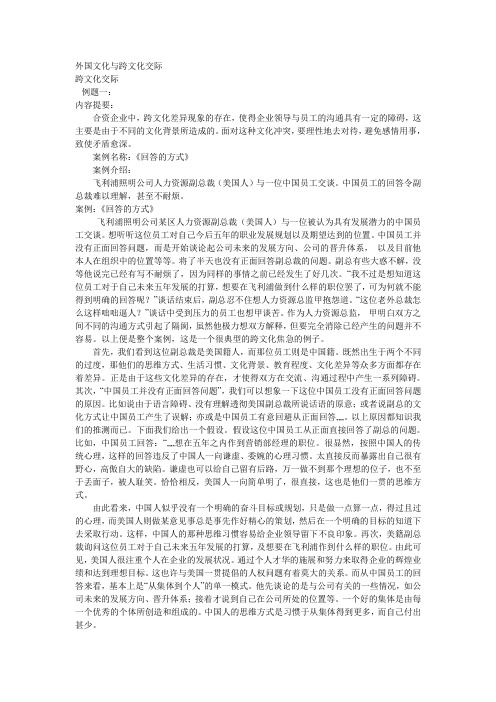
外国文化与跨文化交际跨文化交际例题一:内容提要:合资企业中,跨文化差异现象的存在,使得企业领导与员工的沟通具有一定的障碍,这主要是由于不同的文化背景所造成的。
面对这种文化冲突,要理性地去对待,避免感情用事,致使矛盾愈深。
案例名称:《回答的方式》案例介绍:飞利浦照明公司人力资源副总裁(美国人)与一位中国员工交谈。
中国员工的回答令副总裁难以理解,甚至不耐烦。
案例:《回答的方式》飞利浦照明公司某区人力资源副总裁(美国人)与一位被认为具有发展潜力的中国员工交谈。
想听听这位员工对自己今后五年的职业发展规划以及期望达到的位置。
中国员工并没有正面回答问题,而是开始谈论起公司未来的发展方向、公司的晋升体系,以及目前他本人在组织中的位置等等。
将了半天也没有正面回答副总裁的问题。
副总有些大惑不解,没等他说完已经有写不耐烦了,因为同样的事情之前已经发生了好几次。
“我不过是想知道这位员工对于自己未来五年发展的打算,想要在飞利浦做到什么样的职位罢了,可为何就不能得到明确的回答呢?”谈话结束后,副总忍不住想人力资源总监甲抱怨道。
“这位老外总裁怎么这样咄咄逼人?”谈话中受到压力的员工也想甲谈苦。
作为人力资源总监,甲明白双方之间不同的沟通方式引起了隔阂,虽然他极力想双方解释,但要完全消除已经产生的问题并不容易。
以上便是整个案例,这是一个很典型的跨文化焦急的例子。
首先,我们看到这位副总裁是美国籍人,而那位员工则是中国籍。
既然出生于两个不同的过度,那他们的思维方式、生活习惯、文化背景、教育程度、文化差异等众多方面都存在着差异。
正是由于这些文化差异的存在,才使得双方在交流、沟通过程中产生一系列障碍。
其次,“中国员工并没有正面回答问题”,我们可以想象一下这位中国员工没有正面回答问题的原因。
比如说由于语言障碍、没有理解透彻美国副总裁所说话语的原意;或者说副总的文化方式让中国员工产生了误解;亦或是中国员工有意回避从正面回答……。
以上原因都知识我们的推测而已。
跨文化交际的分类

跨文化交际的分类
1. 语言类跨文化交际呀!就像学英语的你和说英语的外国人交流,互相理解对方的意思,哎呀,那可真是奇妙又充满挑战呢!比如你去国外旅行,跟当地商贩讨价还价,多有意思呀!
2. 非语言类跨文化交际呢!比如说肢体语言,你点头表示同意,可在有的地方点头却是不同意呀,哇,是不是很神奇?就像你和一个来自不同文化的朋友聊天,他的一个手势让你摸不着头脑,哈哈!
3. 风俗习惯类跨文化交际!这就好像你去到一个新地方,发现他们的节日庆祝方式和你完全不同,惊奇不?就像春节在我们这儿热热闹闹,而在别的地方可能有完全不一样的庆祝呢!
4. 价值观类跨文化交际哟!不同文化对于成功、家庭的看法可能天差地别呢,这不就是人生的奇妙之处吗?比如你和一个外国人探讨职业选择,你看重的他可能完全不理解呢,真有趣呀!
5. 宗教信仰类跨文化交际呀!这可不能小瞧,信仰的力量可是很大的呢!像不同宗教的仪式和禁忌,哎呀,可得小心别冒犯了。
就像你突然去到一个宗教氛围很浓厚的地方,得花时间去了解呀!
6. 教育类跨文化交际呢!不同文化下的教育方式那差别可大了,这多值得探索呀!比如你看到国外孩子的学习方式,会惊叹原来还可以这样呀!
7. 艺术审美类跨文化交际!艺术无国界呀,但审美却可以很不同哟!像不同文化的绘画、音乐风格,哇,那真的能让你大开眼界。
你想想听一场异域风格的音乐会,是不是超震撼?
8. 社交礼仪类跨文化交际呀!见面打招呼的方式、用餐礼仪等等都不一样呢,这多好玩呀!就像你在国外参加一场正式晚宴,得按他们的礼仪来,是不是感觉既新鲜又紧张呢!
我觉得呀,跨文化交际真的是丰富多彩、充满惊喜和挑战的呢!我们应该多多去了解和体验不同文化,让世界变得更加多元和有趣!。
【精选】跨文化交际word版(1)

Unit 1 introduction一.文化文化是冻结了的人际交流,而交流是流动着的文化----W.B. Pearce, 1994.背景:长期以来,文化被认为是无处不在,无所不包的人类知识和行为的总体。
被笼统地当作“生活方式”,社会生活的一切方面,积淀物,价值观念体系,众多规范,乃至艺术,政治,经济,教育,修养,文学,语言,思维的总和。
概括地讲,文化即是人们所思,所言,所为,所觉的总和。
在不同的生态或自然环境下,不同的民族创造了自己特有的文化,也被自己的文化所塑造。
It is said that there are at least 150 definitions about culture.“Culture may be defined as what a society does and thinks”(Sapir, 1921) “Culture is man’s medium, there is not one aspect of human life that isnot touched and altered by culture. This means personality, how people expressthemselves, including shows of emotion, the way they think, how they move, howproblems are solved, how their cities are planned and laid out, how transportation systems function and are organized, as well as how economic and government systems are put together and fuction.” (E.T. Hall,1959)“A culture is a collection of beliefs, habits, living patterns, andbehaviors which are held more or less in common by people who occupy particular geographic areas” (D.Brown, 1978)文化的特性:1). 文化是由人们的内隐和外显行为组成的。
跨文化交际1 (1)

Chapter One:Culture and Communication1.The Importance of Learning about CulturesCase 1. Read the following case and try to explain the underlying reason.Case 1. The following case involves an American businesswoman and a British Businessman.“We seeme d to get along great on the telephone. It was a relief after several years in Eastern Europe to actually be doing business with the British. At least we spoke the same language,” says the American businesswoman. “We thought alike. I trusted him.”All went well until the American traveled to London to meet face-to-face with her British colleague to sign a research and development contract. The first meeting did not go well. “ There was something that didn‟t seem right,” she says. “Throughout the presentation none of the Brits, not even the guy I had developed a phone relationship with, would look us in the eye. It was like they were hiding something.After a lot of internal discussion, we decided to sign the contract, but many of us still felt uneasy. Even wh en we talked on the phone later I just couldn‟t get the failure of them to look me in the eye out of my head. It almost ruined the relationship and sunk the deal.”2.Understanding Culture2.1 The Definition of Culture(p2-p4)What’s culture?2.1 Larry A. Samovar and Richard E. Porter’s Definition of Culture (p4):The deposit of knowledge, experience, beliefs, values, attitudes, meanings, hierarchies, religion, notions of time, roles, spatial relations, concepts of the universe, and material objects and possessions acquired by a group of people in the course of generations through individual and group striving.文化的定义:文化是一个大群体在代代相传中,通过本人和集体的努力获得的知识、经验、信念、价值、态度、角色、空间关系、宇宙关系的积淀,以及他们获得的全部物质的东西。
跨文化交际_第一章_第一节_绪论

影响交际的因素
文化背景
价值观、文 化取向、社 会结构、心 理因素和环 境因素等
交际情景
交际双方地位、 角色关系、交 际发生的场合、 时间、话题等
代码系统
“文化”过滤机制
编码的本质是一种约定。即能指和所指之间的关系 是约定的,它取决与使用者(信息发出者和信息接 收者)之间的一种协定。
东西方人的表情符号差异,你看懂了没?
传送者 编码
渠道
信息
渠道
接收者 解码
回馈 接收者 传送者 噪音 编码 ﹋ ﹋ ﹋ ﹋
解码
(三)语言
语言是人类最重要的交际和思维工具。 1、语言是交际工具 (1)交际媒介与语言符号 • “符号”: 用某种能感知的形式来代表某种事物或现象的 结合体。 形式 意义
• 媒介——声音
• 语言符号的特征——约定俗成
人们所思、所觉、所言(言语和语言)、所为 的总和。在不同的生态或自然环境下,不同的民族 创造了自己特有的文化,也被自己的文化所塑造。 狭义:(精神方面)指社会的意识形态、风俗 习惯、语用规范以及相应的社会制度和社会组织。
广义:(精神和物质方面)指人类在历史发展 过程中所创造的物质财富和精神财富的总和。
语种 无意义形式 日语 英语 汉语 68.3 37.9 47.2 惯用表达式 17.0 34.2 31.1 重复式 承上启下式 合作完成式 2.2 1.3 5.8 12.5 10.4 14.5 0 15.6 8.9
跨文化交际实用教程Unit1精品PPT课件

5) Culture is the total accumulation of beliefs, customs, values, behaviors, institutions and communication patterns that are shared, learned and passed down through the generations in an identifiable group of people.
Learn the notions of Culture, Communication and Intercultural Communication.
Learn the differences between Chinese and Western cultures
3
CONTENTS
I. Warm-up Cases II. Culture III. Communication IV. Intercultural Communication V. The Differences between Chinese and
Western Cultures VI. Case study VII. Assignments
4
I. Warm-up Cases
Please discuss the cases in groups and make a comment on it.
Case 1: Showing Concern In China: Xiao Li (an interpreter): You must be
10
Case 2 First Offer
A Canadian colleague and I traveled to Guilin with our admirable guide Heping Liu in very hot weather. Sightseeing is a thirsty business. We did not trust the water, and enjoyed excellent beer. We politely offered some to Heping but he refused. We said nothing and drank our beer, while poor Heping watched. On another day, Heping quickly accepted our offer of beer. Questions for discussion In your daily life, do you often accept first offer? If yes, in what situation?
跨文化交际Unit 1(大二英语)
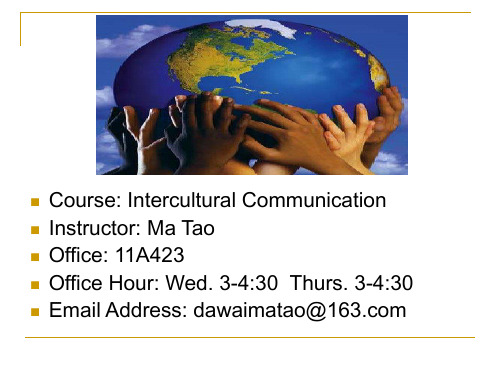
If you have a question to ask your foreign teacher of English, you may say goodbye to him and leave immediately after you have got the answer and expressed your gratitude. On his way to the school cinema, Li Hong saw Professor Jones walking to the cinema, too. Li said, “You’re going to see the film, aren’t you? On a cold winter day you met Professor Brinser on your way to the library. You said to him, “It’s rather cold. You’d better wear more clothes”.
ICC
Interracial Com.
Interethnic Com.
Case 1
My Japanese friend Satsuki was engaged with her American boyfriend Joe and brought him to her parents in Tokyo.
Course Objectives
get the basic information about communication and cultures and try to understand how culture influences our interaction with people of different cultural groups. raise cross-cultural awareness. get mind-prepared to predict and solve possible problems in intercultural communication. better understand and appreciate the Chinese people, Chinese language and Chinese culture.
- 1、下载文档前请自行甄别文档内容的完整性,平台不提供额外的编辑、内容补充、找答案等附加服务。
- 2、"仅部分预览"的文档,不可在线预览部分如存在完整性等问题,可反馈申请退款(可完整预览的文档不适用该条件!)。
- 3、如文档侵犯您的权益,请联系客服反馈,我们会尽快为您处理(人工客服工作时间:9:00-18:30)。
Course Description
It is imperative that people, both present and future, be sensitive to differences in intercultural communication. Business today cannot go further without cross-cultural communication.
1.2 Language is the vehicle of culture, it reflects culture.
语言是文化的载体,文化是语言的土壤 The cultural connotation carried by language and customs is the most difficult point in language learning. Language is not only a kind of social phenomenon, but also a kind of cultural phenomenon.
The
planet Earth is not shrinking, but time and space are. Modern transportation and communication reduce time and distance. A closed relationship ties all people together. No nation, group, or culture can remain isolated. If you touch one part of the world, you touch all parts.
The Course Purpose
to help students grasp the perspectives, theoretical issues, principles and methodologies of the study on the course. to solve and avoid culture shock during the process of communicating.
The Course Purpose
It is to find out the cultural responses when multicultural people meet each other. to understand how cultures influence languages to help students understand the relationship between language and culture
Course Description
If one is good at a foreign language, it means this person has access to better cross-cultural communication, but knowing a foreign language doesn’t mean that one can communicate with people of the language without problem.
Course Description
Introduce some theoretical issues of intercultural communication to explain differences and similarities in intercultural communication. And use some cases to get further understanding about the dimensions of intercultural communication in the world. Offer you opportunities to do critical thinking, practicing and also doing presentations in class.
I. The purpose of intercultural communication studies
1.1 If you touch one part of the world, you touch all parts 1.2 Language is the vehicle of culture. It reflects culture. (语言是文化的载体, 文化是语言的土壤)
In the global village, nations are like families and continents are like neighborhoods. In a globalizing society, your neighbor may be an American, an English, or a French which seemed incredible before. But now it is possible. Globalization is a process of spreading the modernization and civilization among the whole world.
The notion of “a tool”
The notion of “a tool” guided us to pay more attention to the study of interrelationship of languages, but ignored the study of the important elements which influence and control languages.
Recommended Reading
The following is a concise list of recommended reading in the area of this subject. Barnlund, D., Communication in a Global Village. In L. Samovar and R. Porter, Intercultural Communication, A Reader. Belmont, Calif.: Wadsworth,1989, 1994. Brisling, R. Cross-Cultural Encounters. Elmsford, N.Y.: Pergamon, 1981. Gudykunst, W. Communicating with Strangers. New York: Random House, 1984.
Marshal McLuhan: the worldwide famous Canadian communicative scholar f you touch one part of the world, you touch all parts
Understanding Media: The Extensions of Man
They are closely related to each other. Being the most active part of a language, a vocabulary shows a lot of cultural differences. We have ignored intercultural communication in our language teaching for a long time. That is because we have been influenced by Stalin’s notion: language is a tool.
《跨文化交际学》上海教学出版社 2003.1 贾玉新著 《文化与翻译》中国对外翻译出版公司 2000.1郭建中著 《语言与文化》上海外语教育出版社,顾 嘉祖 2002.12
Introduction
I. The purpose of studying IC II. The study of IC III. Multi theoretical issues and frameworks in IC IV. The trend of IC studies
Course Evaluation and Grading System
A grade for this course will be devised from the number of points earned by each student, based on the system described below. 1. Oral presentation: 10% 2. Papers: 10% 4. Creative activities, Class attendance: 10% 5. Final exam: 70%
Course Description
This is a one-semester course (32 periods altogether) for under-graduate students. This course is intended to discuss about the unique relationship between language and culture in communication. It is about what happens when people from different cultures come together to share ideas, feelings, and information.
